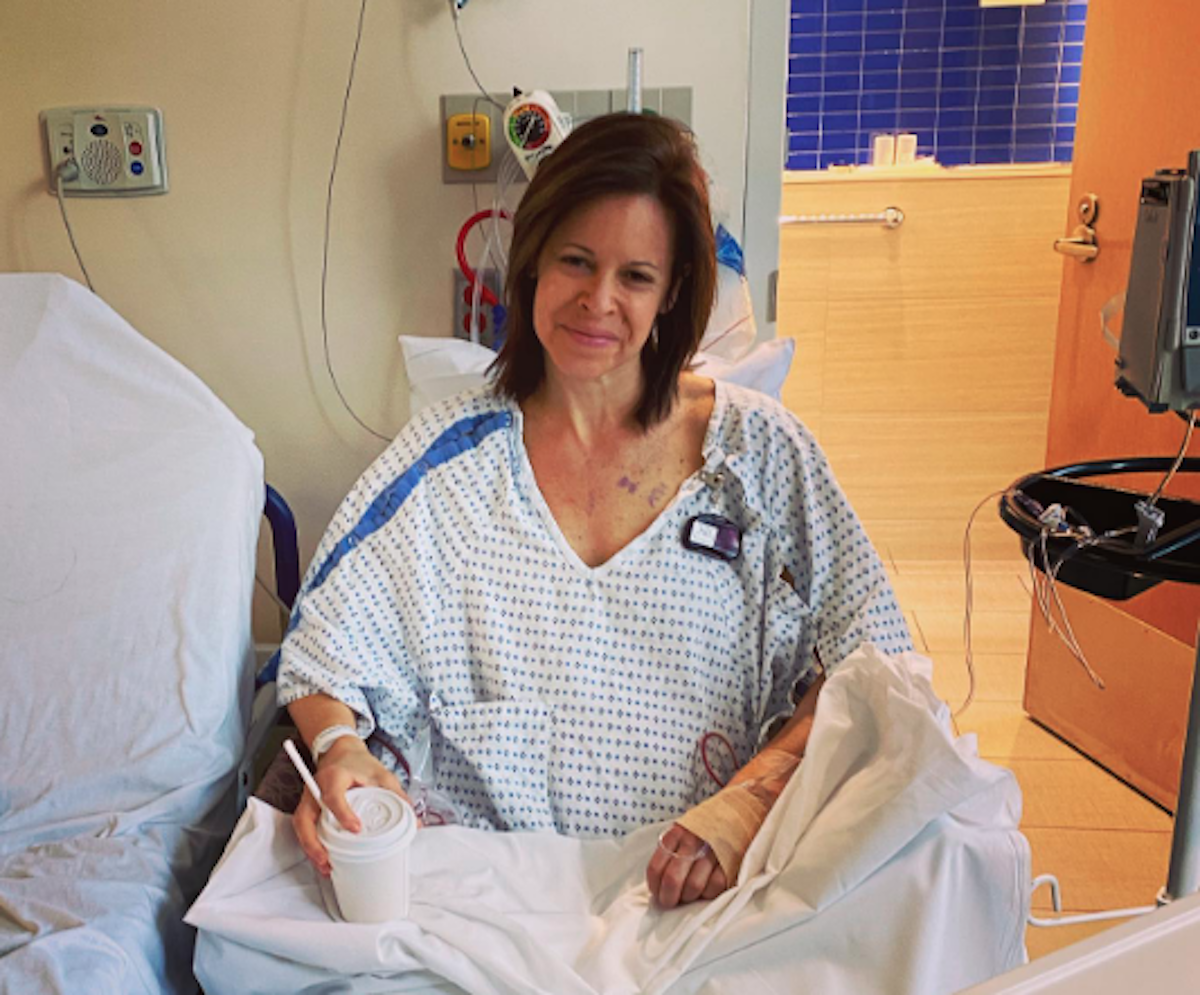Jenna Wolfe's Preventative Surgeries
- Former NBC journalist Jenna Wolfe’s underwent both a preventive mastectomy (breast removal surgery) and hysterectomy (a surgical procedure that removes your uterus).
- This helped minimize her risk of developing ovarian and breast cancer.
- She recently said that even though the recovery can be “sometimes ugly,” the procedures were “worth it.”
- She underwent the preventative hysterectomy and mastectomy after revealing she has tested positive for the BRCA-1 gene mutation.
- That mutation is associated with a woman’s increased risk of developing breast and ovarian cancers.

Just a few days ago, Wolfe took to Instagram to share a photo of herself gently smiling as she continues to heal.
Read More“On the bright side, glass half full, silver lining… I finally finished Succession (well I'm all caught up), I read 2 books, finished a crossword puzzle in under 35 minutes, learned all about the debt ceiling, and can now arrange multiple play dates for my kids with multiple transportation legs on multiple days (always tricky when I can't drive yet). I'm getting there. Thank you for everyone's well wishes and encouraging words. X”
More Preventative Surgery Stories
- Dating After Preventative Cancer Surgery — Meet Pre-Vivor Erika Stallings
- “It’s Not The Choice For Everyone, But It Was For Me”: Nina Garcia of “Project Runway” Opens Up About Preventative Mastectomy
- 26-Year-Old’s Breast Cancer Diagnosis Inspires Mom to Get Preventative Mastectomy How Genetic Testing Can Give You the Power of Knowledge When Cancer Risk Runs in the Family
- 6 Years Have Passed Since Angelina Jolie’s Preventative Double Mastectomy — Here’s What You Need To Know About Inherited Risk For Breast Cancer
- Breast Cancer Survivor and Journalist Susan Berger Says Reporting on the PALB2 Mutation May Have Saved Her Life; What You Should Know about Genetic Testing and Preventative Surgeries
Wolfewho is married to NBC correspondent Stephanie Gosk, 50, and shares two children with herhas been dubbed a “previvor” after undergoing preventative surgeries to reduce her cancer risk.
She underwent the procedures after revealing she has tested positive for the BRCA-1 gene mutation, which is associated with a woman’s increased risk of developing breast and ovarian cancers.
Wolfe hasn’t explained the reasoning behind her decision to undergo genetic testing, but it’s likely because her mom has “just beat” stage 3 breast cancer, according to People.
In Wolfe’s previous Instagram post, she opened up about how she’s doing post-mastectomy, writing, “I FaceTimed with my kids tonight and the little one said to me, ‘you always say we can do hard things, mama. Now we're telling you the same thing. You got this. We love you.’

Wolfe explained that the hysterectomy she underwent was done first, insisting it was “something I need to do.” She underwent a mastectomy two weeks later.
A hysterectomy is the second-most common surgery performed among women, following a Cesarean section, or abdominal child delivery, according to Cleveland Clinic.
When she first opened up on social media about how she felt when learning she had the BRCA-1 gene mutation, Wolfe wrote, “Something like this spins your head a few whirls. Am I going to be ok? Will I heal?”
Wolfe shares her two daughters 9-year-old Harper Estelle and an 8-year-old Quinn Lily with her partner Gosk.
"But I also know I have to let myself be scared sometimes to learn how to overcome it. It's easy to ignore the hard things and opt for the comforts of safety,” she added.
“But safety never challenged anyone or scared anyone or pushed anyone down or pulled anyone up. Safety just sort of sits there, keeps you from moving… from growing, from thriving. But with anything in life, the only way is through. And I'm going through.”
Is a Preventative Mastectomy Right for Me?
When to Consider Preventative Surgery
According to the American Cancer Society, women may choose to undergo preventative surgery if they:
- Have a BRCA1 or BRCA2 gene mutation (or other genes that raise breast cancer risk) found through genetic testing
- Have a strong family history of breast cancer (for example, if a few close relatives have the disease, or if breast cancer has been diagnosed in at least one relative at a young age)
- Underwent radiation therapy to the chest prior to turning 30 years old
- Have (or have had) cancer in one breast
Meanwhile, the American Society of Clinical Oncology, explains that germline mutations in BRCA1 or BRCA2 genes increase a woman's risk of developing hereditary breast or ovarian cancers and a man's risk of developing hereditary prostate or breast cancers.
These mutations also increase the risk of pancreatic cancer and melanoma in women and men.
Luckily, genetic testing is one way to know your inherited risk of developing certain cancers.
Genetic Testing for Breast Cancer: What is This Type of Test? And What Do My Results Mean?
Dr. Elisa Port, a surgical oncologist at Mount Sinai, told SurvivorNet in an earlier interview, “Genetic testing is an exploding area, and it started out with a very narrow field of women and men who were recommended to have it based on certain risk factors, family history of breast cancer or other cancers and also ethnic backgrounds.”
“We now feel that casting a wider net with genetic testing is probably very prudent because finding out that one has a cancer predisposition gene can definitely change their course, their risk for cancer and what they might want to do about it,” she explained.
There are many different gene mutations that can raise your risk of specific cancers, however, we’re focusing on the BCRA mutation as it’s relevant to Wolfe’s case.
BRCA is actually two genes (BRCA1 and BRCA2). BRCA1 (BReast CAncer gene 1) and BRCA2 (BReast CAncer gene 2) are genes that produce proteins that help repair damaged DNA, according to the National Cancer Institute.
Everyone is born with two copies of each of these genes one inherited from each parent. If either parent carries a BRCA gene mutation, there's a 50-50 chance the child is carrying it as well.
When these tumor suppressor genes have certain mutations or changes, cancer can develop raising men’s and women's risk levels for breast cancer as well as several other cancers, most notably ovarian cancer.
"If a woman has one of these mutations the genetic BRCA1 and (BRCA)2 mutations, it puts her at basically the highest quantifiable risk for getting breast cancer," Dr. Port explained.
"We typically say between the 60 (percent) and 80 percent range.”
What Are the Options if You Have a High Risk of Developing Breast Cancer?
"Specific mutations in BRCA genes lead to an increased risk of developing breast cancer," Dr. Freya Schnabel from the NYU Langone Medical Center previously told SurvivorNet.
"People who have a family history of breast or ovarian cancer may want to consider being tested for mutations, particularly if the relative was diagnosed with cancer before age 50."
Dr. Schabel also explained that if you've been diagnosed with a BRCA mutation, there are steps you can take to reduce your risk of developing a cancer.
A preventative mastectomy may be the way to most lower your risk of breast cancer.
"When I meet with women who are at an increased risk for breast cancer because of BRCA mutations, I like to talk about the three options that they have for managing their risk," she said.
- Intensive surveillance: "This means keeping an eye on your health, in an attempt to catch disease early if it does present itself."
- Medication: "There are certain drugs available to lower the risk of developing breast cancer," Dr. Schabel says. "But as with any medical treatment, risks and benefits must be considered."
- Surgery: "This is the option that will lower a woman's chance of getting breast cancer as much as possible," she says. "It involves removing as much breast tissue as possible, while attempting to preserve the nipple area, should a woman opt for reconstruction."
Dr. Schnabel noted, “By newer surgical techniques, patients having prophylactic mastectomies will frequently have the option for having the surgery done in a way that preserves the nipple and areola.”
Prophylactic surgery means removing one or two breasts to reduce the risk of breast cancer.
The Tough Decisions: When You Know You Have a High Risk of Getting Cancer
Women who discover they are BRCA mutation carriers, or have a strong family history of disease even without a known mutation, have difficult decisions to make.
"There's no one right way to go about this," Barbara Dehn, nurse practitioner at El Camino Women's Medical Group, told SurvivorNet in an earlier interview.
“If you've been diagnosed with a BRCA-1 or -2 mutation, or you've been told you have a higher risk because of another genetic mutation, the most important thing you can do is talk to a genetic counselor and then get several opinions. You can also talk to a gynecologic oncologist about minimally invasive surgery.”
RELATED: The Pros and Cons of Prophylactic Surgery for Ovarian Cancer
"It's important to get all of your options ahead of time, and to take your time making this decision," Dehn says.
"It's also important to talk to other women who've gone through this so that you know what to expect afterward."
Contributing: SurvivorNet Staff
Learn more about SurvivorNet's rigorous medical review process.

